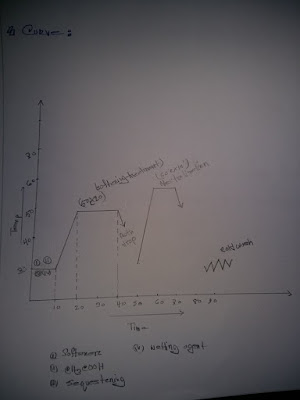Theory: Fabric softener is a chemical compound that prevent
static cling and confers many other desirable to Bundy that has been machine
washed. They are available as solution and solids, sometimes impregnated in
dryer sheets. Dry fabric softener are typically supplied in the form of dryer
sheets, which are added to clotting in the tumble driver to softer the fabric
and prevent buildup of static electricity is susceptible fabric. Many
attractive uses of dryer sheets have been suggested by users such as dusting and
removing hair from clothes.
Recipe:
Softener -4 g/l
CH3COOH – 0.5 g/l
Wetting agent -1 g/l
Sequestering agent -1 g/l
Levelling agent -1 g/l
Temperature – 50°C
Time – 2o min
M: L -1:40
PH – 6/7
Fabric weight -5 g
Neutalization:
Na2CO3 -2 g/l
Temperature - 60° C
Time 10 min
Function of the chemical required:
Softener:
- A product designed to impart a soft mellowness to fabric. Example are glucose, follow or any of a number of quaternary ammonium commands.
- A substance that reduces the hardness of water by sequestering the calcium and magnesium ions.
- A substance used to reduce friction during mixing and processing when dry powders are added to polymers.
Sequestering agent: it one kind of surfactants, surface active agent act in solid- liquid, solid gas interface and reduce the interfacial tension.
Wetting agent : It accelerates the wettability of material
in solution thus helps to easy penetration of chemical into substrate.
Recipe calculations:
The ratio M:L = 1:40
So, the water required = 5× 40 =200
For 1000cc water, softener required 4 gm
1 “ “ “ “ 4/1000 “
200 cc “ “ “ “ (4×200)/1000 “ = 0.8 gm
Similarity,
CH3COOH = 1 g/l
Wetting agent = 0.2 g
Seq agent = 0.2 g
Shade attatchment:
Conclusion: now-a-days softener treatment on cotton fabric
is very popular fan total industry because it is reducing the friction during
mixing and processing.

No comments:
Post a Comment